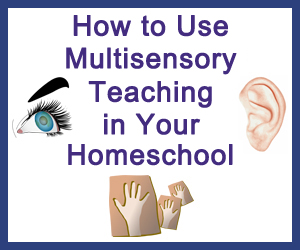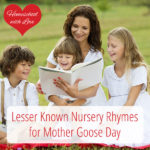
You’ve probably heard the saying, “Two heads are better than one,” right?
Well, the same goes for your child’s senses when it comes to learning.
As I explained in Help Your Child Learn with Multisensory Teaching, sometimes it is best to involve two or three senses in the learning process. This is called multisensory teaching and it can be handy in a number of situations such as helping a struggling learner and teaching a group of children with different learning styles.
Using multisensory teaching isn’t as difficult as you might think. In fact, you may already be doing it without even realizing it. Let’s look at what kinds of activities you can use for this teaching method and how you can use them in your homeschool.
How to Implement Multisensory Teaching
In order to use a multisensory approach, you need to know what kinds of activities go with each of the three major senses that we use for learning: vision, hearing, and touch. (We can use smell and taste too, of course, but we don’t do so very often) Below are some lists of activities categorized by sense for you to use. When you need to do multisensory teaching, simply choose some activities from these lists and implement them into your lesson. You’ll also find one list near the end of this post that has activities which use all three senses. You can also choose one of these to cover all bases if you so desire.
Visual Activities
- Reading (i.e. Living Books, textbooks, library books, etc.)
- Writing
- Drawing pictures or diagrams
- Using graphic organizers
- Mapping
- Note taking
- Flash cards
- Dictation
- Watching videos
- Puzzles
- Diagramming sentences
- Journaling
- Copywork
- Lapbooks
- Notebooking
Auditory Activities
- Read alouds
- Narration
- Listening to lectures
- Watching videos
- Using rhymes, songs, or chants
- Audio books
- Oral discussions
- Recitation
- Giving speeches
- Talking through problem solving
Kinesthetic Activities
- Hands-on activities
- Sensory bins
- Lapbooks
- Modeling
- Using manipulatives
- Science experiments
- Using objects with texture
- Jigsaw puzzles
- Clapping out syllables
- Art projects
- Notebooking
- Games that involve movement
- Role playing
- Using hand gestures
Activities that Combine All Three Senses
- Montessori activities
- Nature studies
- Unit studies
- Field trips
- Reader’s Theater and other drama
Here’s one example of how you could do multisensory teaching with a lesson. Suppose you wanted to teach your children about the Egyptian pyramids. You could read aloud a book to them about the pyramids (auditory), have them draw a pyramid (visual), and let them create a model of a pyramid out of LEGOS (kinesthetic). You have covered all three senses with just a few activities.
I hope you found this post helpful. Feel free to share it with friends because sharing makes the world go round.







